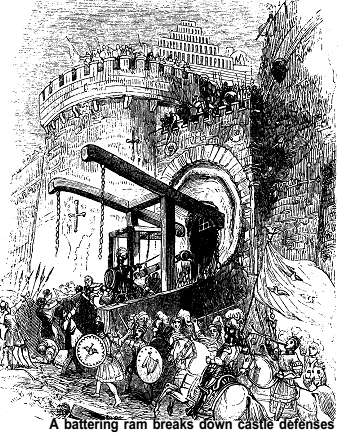

The besieging of castles
became a
science during the Middle Ages. Four
principal methods were employed: mining,
escalade, blockade, and the destruction of fortress walls by siege artillery.
Each of these methods required
specific techniques, and had distinct
advantages and disadvantages. Sieges that
relied totally upon one attack method
were rarely successful.
Mining
Mining
is an ancient art. The Assyrians
made effective use of tunneling cavities
and undermining foundations of great
ancient fortresses (920-586 B.C.). Special
sapper (miner) units were part of the
Assyrian army.
The siege tactic of mining consisted of
digging a tunnel from the besieging line
to an area under a portion of a fortress
wall or tower, at which place a large
cavern would then be hollowed out. The
mine roof would be shored up as the
tunnel was constructed to prevent any
subsidence of the soil above the besiegers
which might alert the defenders to
the tunnel’s existence. The completed
cavern would then be packed with flammable
materials that had been soaked in
animal fat or petroleum. When the material
was set afire, the blaze would burn
the shoring, which would cause the
ground to collapse and a portion of the
wall to fall. In the 15th century, gunpowder
was frequently detonated beneath the walls, producing even more
dramatic effects.
Miners were also used for work above
the ground. Under covering fire, miners
would work their way to the base of the
castle wall. Using picks, they would
weaken rather than breach the wall, to
avoid having the wall fall before the
miners could leave the area. A fire of brushwood or some well-aimed blows
from a
battering ram or a catapult would complete
the destruction of the wall. Corners
were especially susceptible to this type
of attack. One remedy found useful by
castle defenders was to replace rectangular
towers with circular ones.
Mining, although effective, could be
countered and defeated. Fortresses designed
with moats or those built on
marshland were particularly difficult
to
undermine. The enlargement and deepening
of the wall foundations provided a
considerable outward slope which made
the miners’ task more tedious. The deeper
the tunnel and the more time required
for
construction, the greater was the chance
for its collapse or detection.
The most effective defense against.
mining, however, was countermining —
the digging of a shaft from the inside
of
the castle to intercept the attackers’
tunnel. Through this shaft the defenders
could break through, overpower the
miners, and then seize and destroy the
tunnel. Another method of destroying
the tunnel was to direct floodwaters or
fire and smoke into the besieger’s tunnels.
Countermining was not without its
perils for the defenders. If the attackers’
tunnel was not taken and destroyed, the
besiegers could be defeated and the
countermine secured as an entrance
into the castle. Another danger of the
countermine would be the further weakening
of the fortress walls, possibly resulting in their collapse just as the
attackers had intended.
One means of detecting the presence
of a mine was to enlist people with extraordinary
hearing abilities to listen for
sounds of digging. A more reliable form
of detection was the placement of pans
of water on the ground at suspected mining
locations. Vibrations seen on the surface of the water could be an indication
of underground mining activity.
Mining was the safest and the most
effective of the four siege alternatives.
Its
main disadvantage was the great length
of time consumed in the operation. Mining
alone seldom achieved the capitulation of a fortress, but often was instrumental
in its fall.
In 1215, on the second day of King
John’s attack on Rochester Castle, the
king ordered all the smiths of Canterbury,
30 miles away, to make as many
pickaxes as quickly as they could. The
pickaxes were issued to miners, who
then tunneled a large cavern beneath
one of the castle’s square-angled turrets.
Grease, obtained from forty bacon pigs,
was used to ignite a fire, which burned
the tunnel’s shoring timbers, causing
the
collapse of the tower. The breach was
gallantly and successfully (for the moment)
defended by the garrison, but the
cost of lives destroyed morale within
the
fortress. The castle surrendered after
48
days of siege.
Mining was not always successful. At
the siege of Carcassonne in 1240, the
attackers’ mine, directed at the barbican
gate, was detected. A countermine was
dug and a strong wall of stones was constructed
inside the barbican. When the
attackers set the fire inside their tunnel
and collapsed the barbican wall, they
were met with an inner wall.
The attackers, undaunted, began to
dig a tunnel toward a wall turret. Another
countermine cut off this attempt and,
following
a bloody underground battle, the
tunnel was seized and destroyed by the
defenders.
Three other attacker's tunnels were
detected, and the defenders of Carcasonne
built palisade walls behind the
part of the wall being undermined. Each
time a portion of the wall collapsed,
the
attackers were met with a new wall behind
it. In the end, the siege was
abandoned.
Escalade
The oldest method of besieging a castle,
and certainly the most costly in terms
of loss of lives to the attacker, was
the
escalade, the scaling of walls in a general
assault. The use of the scaling ladder
originated in ancient times. At the siege
of Deshashe (24th century B.C.), Egyptian
forces scaled the walls with ladders.
A 23rd century B.C. Egyptian drawing
illustrates a mobile scaling ladder resting
on two wheels, which allowed for its
quick movement over the field of fire
to
the fortress wall. The Assyrians, in contrast,
favored escalade in order to draw
defenders away from their battering rams,
and to take advantage of the defenders’
concentration against the siege machines
by suddenly scaling a lesser defended
wall.
The lattice medieval scaling ladder
had several refinements over its ancient
cousins — steel tips to plant them firmly
in the ground, combined with hooks
which dug into the wall.
During an escalade, it was a race between
the attacker to climb up and over
the wall before the defender could dislodge
and push away the ladder. The
survival of the scaling troops depended
more on speed and nimbleness than on
courage and dedication. The ladder must
be ascended quickly, and also, agility
in
climbing into the tower was a necessity.
Hands which suddenly appeared on the
battlements
were chopped off, heads
split open. The falling bodies of comrades
who preceded themwas a hazard
to escalating troops, in addition to boiling
water, burning straw and blinding
lime poured over the wall at the point
of
attack by the defenders.
The escalade was the least often used
method of attacking castles. The cost
to
the attacker in manpower frequently outweighed
the potential for victory. However,
when used in conjunction with other
forms of attack, the escalade could b
effective, especially if the element of
surprise could be achieved.
Blockade
The least costly in lives, at least to
the
attacker, was the blockade. The first
step
was to extend besieging lines until the
castle was completely surrounded. If the
blockade was effective, the defenders
could not escape and reinforcements
could not be brought into the castle.
Next, the surrounding countryside was
scoured for all foodstuffs, securing necessary
rations for the attackers and
denying the same to the defenders,
should they successfully sally out on
a
search for provisions.
The final step was to wait. Eventually,
the attackers hoped, the garrison rations
would be depleted and starvation would
force them to fight or to capitulate.
However, more than one blockade siege failed
because the garrison’s well-stocked
provisions lasted longer than those of
the besiegers.
There were dangers to the unwary besieger,
such as a surprise sally from the
castle which could cause many casualties,
destroy investure obstacles, and
possibly allow the defenders to capture
supplies and food. Also, reinforcements
could pin the besieger between two opposing
forces — and even lead to the
besieger becoming the besieged.
But the greatest enemy of the besieger
was time. There are numerous accounts
of garrisons holding out for months,
even years. Few attackers could afford
to
devote great amounts of materials and
manpower for great periods of time.
Troops needed to be supplied with food
and pay, and serfs and vassals had fields
back home to farm. Boredom caused a
heavy desertion rate.
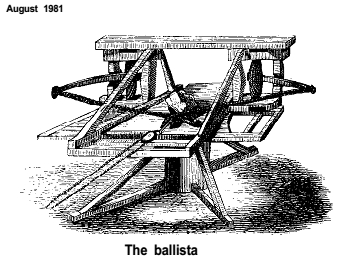
As soon as men banded together to
form cities, defensive walls were erected.
Whether these walls took the form of
mounds of dirt, wooden stockades or
stone walls, they represented substantial
barriers for an attacker to penetrate.
In the end, victory or retreat often depended
upon the besieger’s ability to
breach the walls with artillery.
Medieval siege artillery saw the continuation
(or reintroduction) of two forms
of artillery, tension weapons and torsion
machines. In addition, a new principle
was added — counterpoise, or counterbalance.
Theballista
resembled a giant crossbow. The rope bowstring was laboriously drawn back
by winches, and a longshafted spear or bolt was placed in the
center groove. When the rope was released,
the spear was projected forward
at a high velocity. A stone-launching
version had a pouch at the midpoint of
the bowstring.
A large ballista could propel bolts
weighing up to 50 pounds, at ranges in
excess of 400 yards, with a shattering
impact. Because of its great accuracy,
ballista firepower could be concentrated
on a single area. The weapon could also
be utilized at nearly point-blank range.
When a spear was fired from a ballista
into massed troops, it penetrated many
“like fowls on a spit,” according to one
historian’s account.
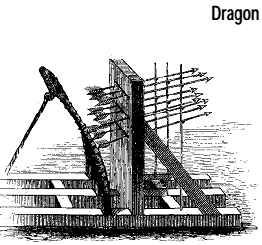
The springal,
also known as the falarich, was a tension siege weapon much
like the ballista. A plank was bent backward
by winch-tightened cords. When
released, the plank shot forward, propelling
a ballista-type missile. Not possessing the power or the accuracy of a
catapult or ballista, it proved a favorite
naval weapon in both ancient and medieval
times because of its ability to launch
missiles of Greek
fire, an incendiary
composition first used by Byzantine
Greeks (see below).
The earliest ballistas are credited to
the scientists of Dionysius the Elder,
ruler of the Greek colony of Syracuse in
Sicily. These early machines fired arrows
which were not much longer than
those of a bowman. By making the drawing
and releasing of the arrow a matter of
mechanics rather than pure manpower,
more powerful machines soon emerged.
The bow sections were built of composite
materials: a wood core surmounted
by a tension layer of animal sinew in
front and a compression layer of horn
in
the back.
Philip of Macedon, the father of Alexander
the Great, subsidized the development of the torsion spring, which
turned the ballista into a fearsome longrange
weapon. Stones weighing as much
as 170 pounds and arrows 25 feet in
length could be fired at targets up to
700 yards away (the maximum range of an
archer being 450 yards). The power of
the ballista is seen at the siege of Gaza
in
332 B.C., where Alexander the Great was
struck in the neck by an arrow which first
pierced both his shield and breastplate.

The catapult, the most famous of pregunpowder
artillery, is first mentioned in
the Old Testament of the Bible during
the eighth century B.C. Uzziah describes
“engines invented by cunning men, to be
on towers and upon bulwarks, to shoot
arrows and great stones withal.
The Athenians made effective use of
catapults during the Peloponnesian War.
In 398 B.C., the City of Motya was taken
by siege
towers containing both battering rams and catapults.

Alexander the Great placed catapults
at various levels of 150-foot-high siege
towers, employed during the siege of
Tyre in 332 B.C. The crossing of the Jaxartes
River against the Asythians was
successfully accomplished due to a continuous
catapult barrage.
The Romans also made extensive use
of the catapult and ballista. Vegetius
mentions that a fourth-century Roman
Legion might contain as many as ten catapults
and sixty ballistas. During the
Viking siege of Paris (A.D. 885-886),
both sides made extensive use of
catapults.
The catapult, also known as the onager,
mangon, mangonel or sling, is an example of the use of torsion. Its framework
was built from heavy timber. A
mass of twisted rope was strung across
near the front. In the twisted rope was
secured one end of a pivoting beam having
a spoon-shaped container at its other end. The free end was pulled backwards
and down by a type of capstan or
large winch located at the end of the
frame, against the resistance of the
twisted ropes. The stone was placed into
the spoon-shaped cavity. By releasing
a
catch, the beam was pulled forward and
upward by the force of the twisted ropes,
hurling a stone toward its target.
The catapult could handle larger projectiles
than the ballista. It did not possess the ballista’s accuracy, however.
Also, a wet or dry day would have an
adverse effect on the ropes, making the
machine even more difficult to operate
dependably.
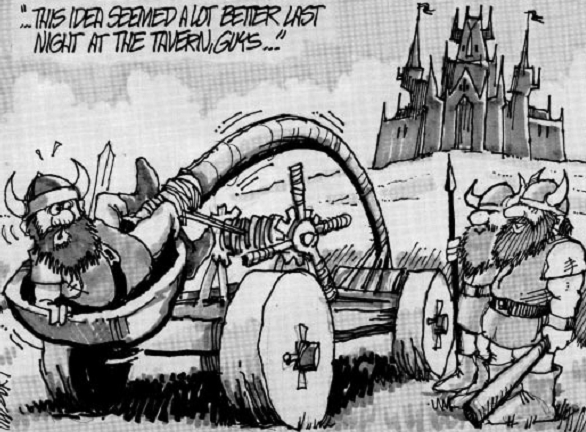
The ranges of catapults varied with
size. Sir Ralph Payne-Gallwey’s intensive
study of these medieval machines
led to the construction of several. His
smaller catapults could throw a onepound
stone 200-300 yards. Larger units
were capable of hurling an eight-pound
round stone a distance of 350-360 yards.
The same machine with a sling fitted to
its arm increased the effective range
to
500 yards.
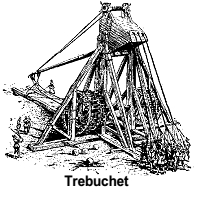
The third type of siege machine, the
trebuchet,
utilizing the principle of counterpoise, was introduced at the end of
the twelfth century. A heavy weight or
group of weights was hung from one end
of a long, heavy beam. A sling or spoon
cup, which held a projectile, was located
at the opposite end. Winches drew the
missile-firing end downward, raising the
weights upward. When the winch catch
was released, the weighted end plunged
to the earth, propelling the missile upward
and towards a target.
Range could be controlled by varying
the amount of weight or the height to
which the weight was raised. A trebuchet
with a 50-foot arm and a 20,000-pound
counterpoise could hurl a 200- or 300-
pound stone a distance of 300-350 yards.
While not a particularly accurate weapon,
the tremendous impact with which
the missiles of the trebuchet struck was
sufficient to continue its popularity
for
some time after the perfection of the
cannon.
Until late in the fourteenth century,
cannon
were too small to play an effective part in siege warfare. Early cannon
could fire only small balls, about four
an
hour (the same as the trebuchet), and
proved to be as dangerous to the user
as
to the target.
In 1377, a cannon capable of firing a
200-pound ball was used at the siege of
Ardes. A weapon of this size, although
able to do great damage, was still unreliable,
expensive to produce and extremely difficult to transport over great
distances.
During the fifteenth century, cannons
large enough to knock down existing
castle walls were developed. In 1424,
English artillery battered down the walls
of LeMans in a few days. The French
took sixty fortresses in the year of 1449
alone, many surrendering as soon as
they saw the besiegers’ big cannon.
The battering
ram also played a key
role in siege warfare. The earliest known
battering ram is depicted on an Egyptian
wall painting from the tomb of Khety
(2100 B.C.). It consists of a long pole
with a bronze spearhead held by three
Egyptian soldiers, with an enclosure protecting
its occupants. The pole is being
thrust upward and appears designed to
pry away at the masonry around stones.
The Assyrians made extensive use of
the ram. During the reign of King Ashurnasiral
(920 B.C.), battering rams consisted of six wheels and a body composed
of rectangular wicker shields.
Below a domed turret protruded an
axeblade-shaped, metal-tipped battering
pole. A lighter, four-wheeled version
consisted of a covered rounded turret with a
large iron spear projecting from its front.
The medieval battering ram possessed
a number of refinements over those of
the ancients. Its strength came from
heavy timbers, frequently cut from the
largest tree available. Its head was fitted
with a metal knob or point, or a facsimile
of a ram’s head. The timber hung from
large chains or ropes anchored into the
roof. The roof, made of wood and covered
with hides, was called a penthouse.
It was designed to protect its users from
arrows, stones and boiling water. The
hides could be kept wet, lessening the
chance of fire damage.
The siege
tower
In order to clear a portion of a castle
wall of its defenders so assault troops
could secure the position, a higher wall
of some sort was necessary. Add wheels
to such a tower (for mobility) and a
drawbridge (for attackers to cross onto
a
fortress wall) and you have the siege
tower, also known as the belfry.
The earliest siege
towers date back to
2100 B.C. These were stationary towers,
without wheels, from which archers could
fire down on the defenders to cover a
general attack. There is no indication
that any attempt was made to push these
machines up to the fortress wall.
The medieval tower was mobile, designed
to provide maximum protection
for its occupants until the moment of
assault. Frequently three stories high,
it
was always constructed to be higher
than the walls being attacked. The lowest
level harbored troops who pushed
the huge, wheeled tower into position.
Assault troops waited in the second level
for the lowering of the drawbridge. The
top story held archers, whose role was
to
sweep the defenders from the area of the
wall attacked.
Other weaponry
The bore
consisted of a long shaft with
a metal point.
The opposite end was attached to an upright shaft by means of a
rod. The point was placed against the
wall and the shaft was slowly turned by
a
winch. The point drilled holes through
joints in the masonry, loosening large
stones. A penthouse enclosure protected
the soldiers working the bore. Although the bore was lighter and easier
to
transport than the battering ram, much
more effort and time
were required to
accomplish the same purpose.
The petard,
an early <limpet> mine, was
occasionally utilized to blow open gates
or knock holes in walls. An iron pot filled
with gunpowder (up to 15 pounds) was
fixed to a board which prevented the spilling
of the powder in transit. One or two
hooks attached to the edges of the board
enabled the bomb to be quickly attached
to a wall or gate, by hanging it from
heavy nails driven into the target if
no
other protrusions were available. A slow
fuse gave the soldiers a chance to escape
before it exploded.
Greek fire
was also extensively used
by both sides. Although some sources
describe its exact composition as “unknown,”
it generally would have had to
consist of a petroleum base for combustibility,
pitch to lengthen burning time,
sulfur to make it stick and quicklime
for
ignition on contact with water.
Fighting back
Behind the fortress walls, the defenders
were far from helpless. Their own
ballistas
and catapults took an enormous
toll on the attackers and their siege
machines. Defenders favored quicklime to
blind assaulting troops. Boiling water
and red-hot sand dropped onto attackers
proved especially good at penetrating
the chinks in their armor. “Stink pots”
of
burning sulfur were also effective.
Boiling oil, even in days of old, was too valuable to waste on attackers unless absolutely necessary.
-
Many other means were also used to
discourage besiegers. Large mattresses
or a series of beams would be lowered
over the area being battered by a ram.
Grapnels or large pincers were lowered
to intercept the head of the battering
ram
and deflect it upward to such an angle
that it was rendered useless. Where a
wall was in danger of being battered
through, a second barrier was erected
immediately behind the endangered section
of the wall.
Bibliography
Beeler, John, Warfare In Feudal Europe,
730-1200 (Cornell University Press,
1971)
Koch, H. W., Medieval Warfare (PrenticeHall,
1978)
Oman, Charles, A History of the Art
of War
in the Middle Ages, Volumes I &
II (Burt Franklin, 1969)
Spaulding, Nickerson & Wright, Warfare,
the Infantry Journal (1937)
Tunis, Edwin, Weapons, World
Publishing,
(1954)
Warner, Philip, The Medieval Castle
(Taplinger Publishing Co., 1971)
Wise, Terence, Medieval Warfare
(Hastings
House, 1976)
Yadin, Yigael, The Art of Warfare in
Biblical
Land, Volumes I & II (McGraw-Hill,
1963)